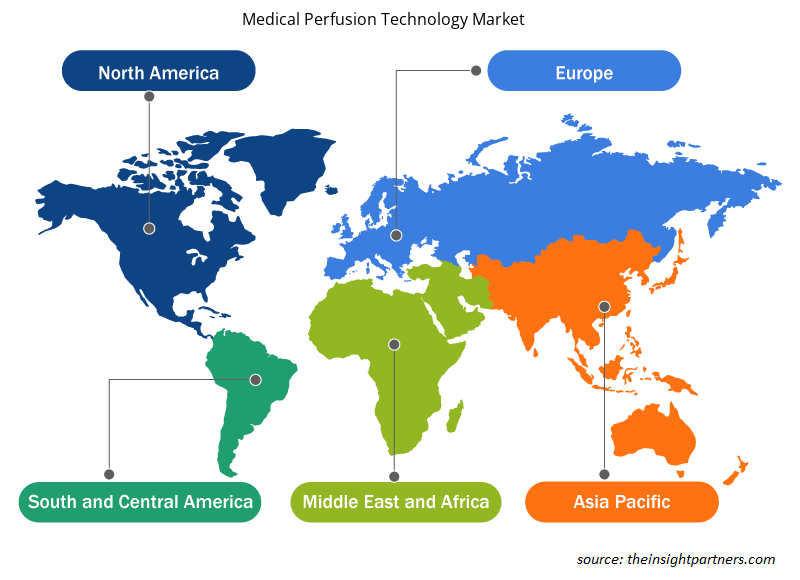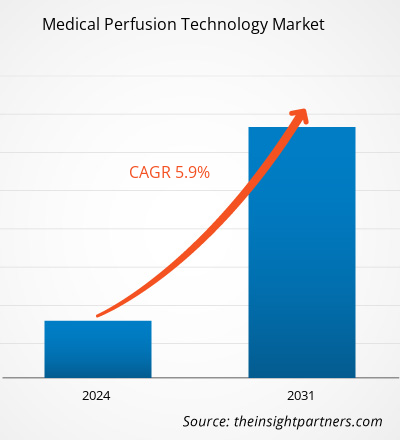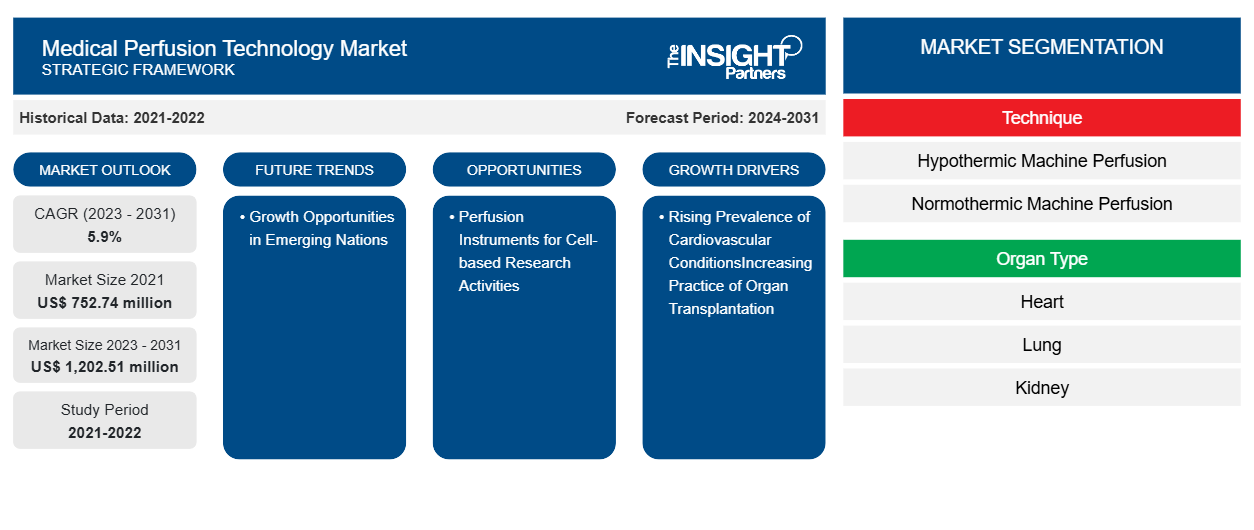El tamaño del mercado de tecnología de perfusión médica en 2021 se situó en 752,74 millones de dólares y se prevé que alcance los 1.202,51 millones de dólares en 2031, frente a los XX millones de dólares en 2023. Se espera que el mercado registre una CAGR del 5,9% entre 2023 y 2031. Es probable que los instrumentos de perfusión para actividades de investigación basadas en células y la adopción de máquinas de perfusión compactas y portátiles sigan siendo tendencias clave del mercado de tecnología de perfusión médica.
Análisis del mercado de tecnología de perfusión médica
La creciente prevalencia de enfermedades cardíacas, como la enfermedad coronaria, la enfermedad cardiovascular, la enfermedad cerebrovascular y la enfermedad cardíaca reumática, así como el crecimiento significativo de las empresas biotecnológicas y farmacéuticas, el aumento de las actividades de investigación basadas en células y la práctica del trasplante de órganos, contribuyen al crecimiento del mercado de la tecnología de perfusión médica. Además, se prevé que la industria de la salud bien establecida, el aumento de la inversión por parte de actores clave y los intentos del gobierno de desarrollar la industria de la salud impulsen el crecimiento del mercado.
Descripción general del mercado de tecnología de perfusión médica
Se prevé que Estados Unidos sea el mayor mercado de tecnología de perfusión médica, debido a múltiples factores, como el aumento de las enfermedades cardiovasculares, la investigación clínica integral, la investigación por contrato y más. Además, en términos de tecnología, el país está muy por delante de otros países desarrollados y emergentes. Los avances tecnológicos han dado lugar al desarrollo de diversas tecnologías de perfusión médica y tecnologías que se utilizan para sus aplicaciones. La enfermedad cardíaca es la principal causa de muerte en Estados Unidos. La enfermedad coronaria se produce cuando las arterias del corazón son incapaces de suministrar suficiente sangre rica en oxígeno al corazón. Según los CDC, el tipo de enfermedad cardíaca más frecuente es la enfermedad de las arterias coronarias (EAC). En 2021, murieron unas 375.000 personas en Estados Unidos.
Personalice este informe según sus necesidades
Obtendrá personalización en cualquier informe, sin cargo, incluidas partes de este informe o análisis a nivel de país, paquete de datos de Excel, así como también grandes ofertas y descuentos para empresas emergentes y universidades.
-
Obtenga las principales tendencias clave del mercado de este informe.Esta muestra GRATUITA incluirá análisis de datos, desde tendencias del mercado hasta estimaciones y pronósticos.
Impulsores y oportunidades del mercado de la tecnología de perfusión médica
La creciente prevalencia de enfermedades cardiovasculares favorece el crecimiento del mercado
Las enfermedades cardiovasculares (ECV) son los trastornos relacionados con los vasos sanguíneos y el corazón, que incluyen la enfermedad cerebrovascular, la cardiopatía reumática y la enfermedad cardíaca coronaria (CHD). Las ECV son la principal causa de muerte a nivel mundial. La alteración estructural y funcional de los vasos se observa principalmente en personas mayores, lo que conduce al riesgo de enfermedades cardiovasculares . Según los Centros para el Control y la Prevención de Enfermedades (CDC) en 2020, la enfermedad cardíaca causa la muerte de aproximadamente 695.000 personas en los EE. UU. cada año. Además, según la OMS en 2020, a nivel mundial ~17,9 millones de personas mueren a causa de enfermedades cardiovasculares. Además, la mayoría de las muertes por ECV se deben a la CHD, a la que le siguen el accidente cerebrovascular y la insuficiencia cardíaca.
Oportunidades de crecimiento en los países emergentes
Las regiones emergentes como Asia Pacífico, Oriente Medio y África y América Latina están creciendo significativamente en los sectores de biotecnología y farmacéutica. Los gobiernos de los países de estas regiones están apoyando a través de varias iniciativas, programas, financiación y conferencias. El crecimiento de la industria farmacéutica y biotecnológica está impulsado por el desarrollo económico y demográfico, el aumento de los gastos sanitarios y la mejora de la financiación pública y privada de la atención sanitaria, entre otros.
Las regiones están siendo testigos de un creciente número de empresas de nueva creación que ayudan en la producción de medicamentos genéricos, componentes de las partes de los dispositivos médicos y otros. Las actividades de I+D en los sectores de biotecnología y productos farmacéuticos están creciendo. Las economías emergentes ahora están buscando el apoyo de las naciones desarrolladas para procedimientos novedosos y tecnologías avanzadas. Además, los actores bien establecidos están recurriendo a las naciones emergentes para sus expansiones, ya que estas regiones tienen un enorme potencial para ofrecer crecimiento del mercado.
Informe de mercado de tecnología de perfusión médica Análisis de segmentación
Los segmentos clave que contribuyeron a la derivación del análisis del mercado de tecnología de perfusión médica son la técnica, el tipo de órgano y el componente.
- Según la técnica, el mercado de tecnología de perfusión médica se divide en perfusión con máquina hipotérmica y perfusión con máquina normotérmica. El segmento de perfusión con máquina hipotérmica tuvo una mayor participación de mercado en 2023.
- Por tipo de órgano, el mercado se segmenta en corazón, pulmón, riñón, hígado y otros. El segmento renal tuvo la mayor participación del mercado en 2023.
- En cuanto a los componentes, el mercado se divide en bombas de perfusión, oxigenadores, máquinas de circulación extracorpórea, sistemas de monitorización, cánulas y otros. El segmento de oxigenadores dominó el mercado en 2023.
Análisis de la cuota de mercado de la tecnología de perfusión médica por geografía
El alcance geográfico del informe del mercado de tecnología de perfusión médica se divide principalmente en cinco regiones: América del Norte, Asia Pacífico, Europa, Medio Oriente y África, y América del Sur y Central.
América del Norte ha dominado el mercado de la tecnología de perfusión médica. Se prevé que la creciente adopción de tecnología de perfusión médica avanzada, los avances tecnológicos y el creciente énfasis en mejorar los resultados del tratamiento aceleren el crecimiento de este mercado. Además, es probable que el aumento de las cirugías cardiovasculares en Canadá y la creciente prevalencia de enfermedades cardiovasculares y asma en la Ciudad de México impulsen el crecimiento de la tecnología de perfusión médica en la región durante el período de pronóstico.
Perspectivas regionales del mercado de tecnología de perfusión médica
Los analistas de Insight Partners explicaron en detalle las tendencias y los factores regionales que influyen en el mercado de tecnología de perfusión médica durante el período de pronóstico. Esta sección también analiza los segmentos y la geografía del mercado de tecnología de perfusión médica en América del Norte, Europa, Asia Pacífico, Oriente Medio y África, y América del Sur y Central.

- Obtenga datos regionales específicos para el mercado de tecnología de perfusión médica
Alcance del informe de mercado de tecnología de perfusión médica
| Atributo del informe | Detalles |
|---|---|
| Tamaño del mercado en 2021 | US$ 752,74 millones |
| Tamaño del mercado en 2031 | US$ 1.202,51 millones |
| CAGR global (2023 - 2031) | 5,9% |
| Datos históricos | 2021-2022 |
| Período de pronóstico | 2024-2031 |
| Segmentos cubiertos |
Por técnica
|
| Regiones y países cubiertos |
América del norte
|
| Líderes del mercado y perfiles de empresas clave |
|
Densidad de actores del mercado de tecnología de perfusión médica: comprensión de su impacto en la dinámica empresarial
El mercado de tecnología de perfusión médica está creciendo rápidamente, impulsado por la creciente demanda de los usuarios finales debido a factores como la evolución de las preferencias de los consumidores, los avances tecnológicos y una mayor conciencia de los beneficios del producto. A medida que aumenta la demanda, las empresas amplían sus ofertas, innovan para satisfacer las necesidades de los consumidores y aprovechan las tendencias emergentes, lo que impulsa aún más el crecimiento del mercado.
La densidad de actores del mercado se refiere a la distribución de las empresas o firmas que operan dentro de un mercado o industria en particular. Indica cuántos competidores (actores del mercado) están presentes en un espacio de mercado determinado en relación con su tamaño o valor total de mercado.
Las principales empresas que operan en el mercado de tecnología de perfusión médica son:
- Getinge AB,
- Medtronic,
- Sociedad Anónima LivaNova,
- Perfusión XVIVO,
- Corporación de sistemas cardiovasculares Terumo,
- OrganOx limitada,
Descargo de responsabilidad : Las empresas enumeradas anteriormente no están clasificadas en ningún orden particular.

- Obtenga una descripción general de los principales actores clave del mercado de tecnología de perfusión médica
Noticias y desarrollos recientes del mercado de tecnología de perfusión médica
El mercado de tecnología de perfusión médica se evalúa mediante la recopilación de datos cualitativos y cuantitativos posteriores a la investigación primaria y secundaria, que incluye publicaciones corporativas importantes, datos de asociaciones y bases de datos. A continuación, se incluye una lista de los avances en el mercado de tecnología de perfusión médica:
- XVIVO Perfusion AB ha completado la adquisición de todas las acciones de la empresa de tecnología médica holandesa Organ Assist BV Organ Assist BV Organ Assist se centra principalmente en el desarrollo de máquinas y consumibles para la perfusión de hígado y riñón. Con esta adquisición, XVIVO se convierte en la primera empresa del mundo en realizar negocios de forma activa en todas las áreas principales de órganos dentro del ámbito de la preservación y evaluación de órganos. La adquisición acelera la estrategia de la empresa de convertirse en un proveedor global de soluciones y sistemas en todas las áreas principales de órganos. (Fuente: XVIVO, Nota de prensa, 2020)
Cobertura y resultados del informe sobre el mercado de tecnología de perfusión médica
El informe “Tamaño y pronóstico del mercado de tecnología de perfusión médica (2021-2031)” proporciona un análisis detallado del mercado que cubre las siguientes áreas:
- Tamaño del mercado y pronóstico a nivel global, regional y nacional para todos los segmentos clave del mercado cubiertos bajo el alcance
- Dinámica del mercado, como impulsores, restricciones y oportunidades clave
- Principales tendencias futuras
- Análisis detallado de las cinco fuerzas de Porter y PEST y FODA
- Análisis del mercado global y regional que cubre las tendencias clave del mercado, los principales actores, las regulaciones y los desarrollos recientes del mercado.
- Análisis del panorama de la industria y de la competencia que abarca la concentración del mercado, el análisis de mapas de calor, los actores destacados y los desarrollos recientes
- Perfiles detallados de empresas
- Análisis histórico (2 años), año base, pronóstico (7 años) con CAGR
- Análisis PEST y FODA
- Tamaño del mercado, valor/volumen: global, regional y nacional
- Industria y panorama competitivo
- Conjunto de datos de Excel
Informes recientes
Informes relacionados
Testimonios
Razón para comprar
- Toma de decisiones informada
- Comprensión de la dinámica del mercado
- Análisis competitivo
- Información sobre clientes
- Pronósticos del mercado
- Mitigación de riesgos
- Planificación estratégica
- Justificación de la inversión
- Identificación de mercados emergentes
- Mejora de las estrategias de marketing
- Impulso de la eficiencia operativa
- Alineación con las tendencias regulatorias























 Obtenga una muestra gratuita para - Mercado de tecnología de perfusión médica
Obtenga una muestra gratuita para - Mercado de tecnología de perfusión médica